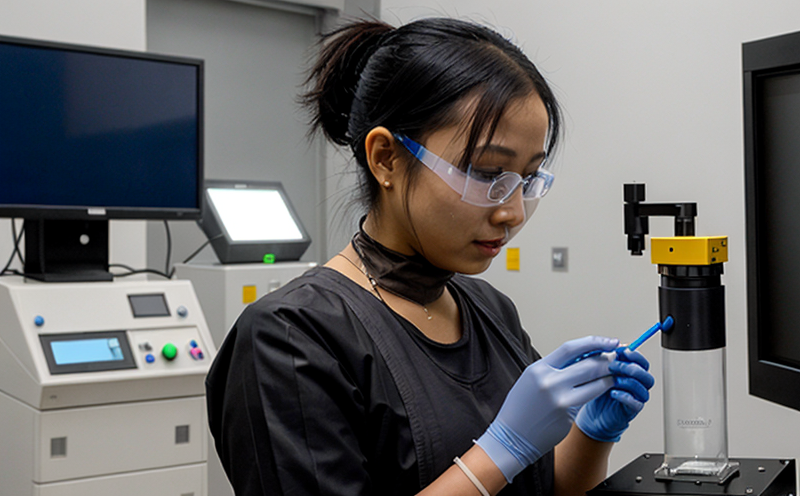ISO 14644 Airborne Nanoparticle Concentration in Controlled Environments
The ISO 14644 series of standards is designed to address the need for clean environments in various industrial sectors, particularly those involving nanomaterials. The standard specifies requirements for air cleanliness and particle concentration control within these environments. In this context, ISO 14644-3, which pertains specifically to airborne nanoparticle concentrations, plays a crucial role in ensuring that the air quality meets stringent environmental standards.
The testing of airborne nanoparticles is essential for several reasons. Nanomaterials have unique properties due to their small size and large surface area, making them particularly potent in various applications ranging from electronics to pharmaceuticals. However, these same properties also make nanomaterials potentially harmful if not handled properly. Therefore, understanding the concentration and behavior of airborne nanoparticles is critical for compliance with environmental regulations.
The testing process involves several key steps. Specimen preparation is crucial; this includes collecting air samples using appropriate sampling techniques such as impactors or filters. The collected particles are then analyzed to determine their size distribution and concentration. This can be done through various analytical methods including scanning electron microscopy (SEM), transmission electron microscopy (TEM), and dynamic light scattering (DLS).
The ISO 14644-3 standard provides detailed protocols for the collection, handling, and analysis of these samples to ensure accurate results. It specifies the types of sampling equipment that should be used, the conditions under which samples must be collected, and the methods for processing the data obtained from the analyses.
The significance of this testing cannot be overstated in terms of both health and safety concerns and compliance with environmental regulations. By adhering to these standards, organizations can ensure that their processes are not only efficient but also environmentally responsible. This is particularly important given the increasing focus on sustainability across industries.
- Competitive Advantage: Compliance with ISO 14644-3 helps companies maintain a competitive edge by ensuring they meet or exceed regulatory requirements, thereby reducing the risk of non-compliance penalties and enhancing their reputation among stakeholders.
- Market Impact: Adherence to these standards can lead to increased market share as consumers become more aware of environmental issues. Companies that demonstrate leadership in this area may attract a higher percentage of eco-conscious customers.
The ability to accurately measure and report on airborne nanoparticle concentrations is vital for quality management, especially in sectors like electronics manufacturing where even the smallest particles can have significant impacts on product performance. Compliance officers will find this service invaluable as it provides them with the data they need to ensure that their facilities meet all relevant standards.
R&D engineers working on new nanomaterials or processes involving nanoparticles will also benefit greatly from such testing services. They can use the results to optimize their processes, ensuring both efficiency and safety. For procurement teams, knowing that suppliers are meeting these stringent standards adds another layer of assurance when selecting vendors.
Applied Standards
In addition to ISO 14644-3, several other international standards contribute to the overall framework for testing airborne nanoparticle concentrations:
- ISO 9001: This standard provides a comprehensive quality management system that can be integrated into any organization's operations. It ensures that processes are consistently effective and produces reliable results.
- ASTM E2847: This American Society for Testing and Materials standard offers additional guidance on the sampling of airborne particles in cleanrooms, which is directly applicable to ISO 14644-3 testing.
The combination of these standards ensures that all aspects of air quality control are addressed comprehensively. By following both ISO and ASTM guidelines, laboratories can provide accurate and reliable data that meets or exceeds regulatory expectations.
Industry Applications
The application of ISO 14644-3 in controlled environments extends across multiple industries where nanomaterials play a key role. This includes:
- Pharmaceutical Manufacturing: Ensuring that production areas are free from harmful nanoparticles is crucial to maintaining product purity and patient safety.
- Electronics Fabrication: Clean rooms in semiconductor fabrication facilities must adhere to strict air quality standards to prevent contamination of sensitive electronic components.
- Biotechnology Research: In laboratory settings, controlling nanoparticle concentrations helps maintain the integrity of experimental results and ensures the safety of researchers.
By implementing ISO 14644-3 testing protocols, these industries can ensure that their operations are not only compliant with international standards but also optimized for efficiency and safety. This is especially important as nanotechnology continues to advance and find new applications in various sectors.





